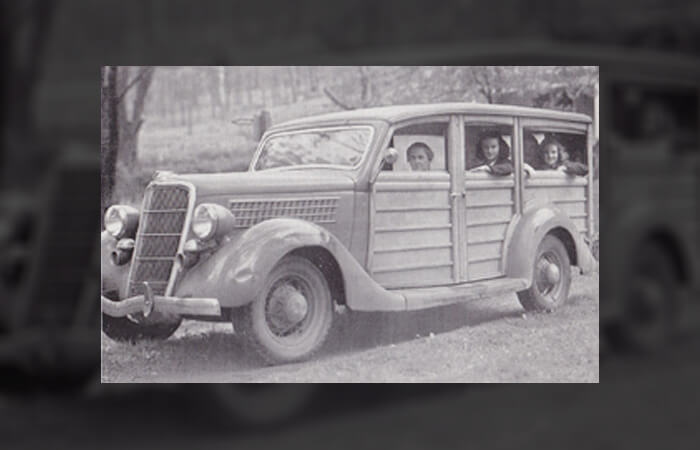Wheeling Country Day School has a rich history of empowering students to think, create, and communicate.
When Miss Bertha Wilson’s school, which was an all-girl school geared for college preparation, announced its closing for the 1929-1930 fiscal year, there was a great deal of concern regarding a replacement with the same type of above-average quality. Therefore, on July 15, 1929, Margaret Holloway (pictured right), Margurite E. MacGregor, Clara W. Rogers, Charles F. Paul, Jr. and Kent B. Hall incorporated The Wheeling Country Day School.
The school was to be at Clara W. Rogers’ house at 9 Hamilton Avenue in Wheeling. However, it never was located there. The first location of WCDS was a few rooms of the lower floor in a house in Woodsdale, 1153 National Road, where the Produce Basket (now defunct) was located.
Each year WCDS founder Mrs. Holloway and the art teacher would take the older students to the International Art Exhibit at the Carnegie Museum in Pittsburgh. This is a photo of Mrs. Holloway and students preparing to depart for on of those trips.

“We have never changed in our emphasis upon first the fundamentals of learning with the richest opportunities and breadth added thereafter. What we are, we have been in a steady unbroken line.”
Miss Virginia K. Heinlein
Head of School 1933-1965
After one year, the school was relocated to the lower floor of a duplex house at 136 Edgington Lane. In 1933, WCDS rented the Russell House, 111 Poplar Avenue. In 1937, when the Board of Directors saw there was a definite interest and future for WCDS, a permanent building was bought at 30 Edgewood Street. In 1941, the Board realized that more students would enroll the following year and the house was already crowded with 50 students, so January 7, 1942, the Parent House (where the gymnasium stands) and the barn (where the administrative building stands), both at 8 Park Road, were purchased from Mr. James Rogers Ewing, a Wheeling attorney. Mrs. Sarah Caldwell purchased the Darien House (where the science building currently stands) and the quadrangle from General Riley and donated it to the school in 1944. In 1967 the Parent House and Darien House were razed and replaced by the gymnasium and aluminum buildings, respectively. A kindergarten building at 5 Hamilton Avenue was purchased. Mr. George Weaver, Jr., was chairman of that campaign. A new kindergarten-2nd grade building made the kindergarten building on Hamilton Avenue unnecessary, so it was sold to William Valentino. The project had Mr. Stuart Bloch as acting chairman of the building project.
The administrative structure has virtually remained the same through the years, governed by a headmaster/headmistress and a Board of Directors. Heads of School have included:
Through the years, WCDS has changed in class range. In 1929, WCDS consisted of grades 1st-8th for girls only. In 1936, the school was opened to boys, but only through fourth grade. The fourth grade boys “graduated” with the eighth grade girls and, instead of receiving a diploma, received a “certificate”, which stated that the boy had completed the fourth grade at WCDS. In 1944, a kindergarten program was added, and in 1966 the boys were permitted to go through the eight grade. Finally, in 1967 the school started a ninth grade for both sexes, with Peggy Hogan as the only person in that first, ninth grade class.
Growing from a student body of seven young ladies in 1929, today the school now has more than 160 students that is more socioeconomically and culturally diverse and enrolls boys and girls in junior kindergarten through fifth grade. Today the school offers six buildings that feature new, state of the art learning spaces where students develop their creativity, collaboration, critical thinking, communication, and character. The campus occupies six acres in the Woodsdale area of Wheeling, West Virginia, and serves families in western Pennsylvania and eastern Ohio as well.
The school’s mission is, “to empower students to think, to create, and to communicate in a nurturing environment where learning and character are paramount.” It’s purpose/philosophy is “to nurture the intellectual, creative, and ethical growth of children from diverse backgrounds. A balanced program of academic basics, fine arts, physical development, and critical thinking develops and enhances student’s individual and cooperative abilities. In a positive environment children learn to be self-reliant, self-motivated, and resourceful learners. A supportive faculty challenges students to learn independently and within a group, with and without direct instruction, and the faculty rewards the students’ best efforts, ambition, and accomplishments. A wide variety of activities beyond the classroom enrich learning opportunities. Personalized instruction using various methods and materials contributes to the total experience.